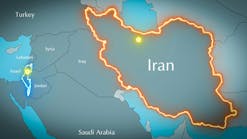- Alliance Limited Partners [35079 bytes]
- Alliance Route[13574 bytes]
- Estimates of Undiscovered Conventionally Recoverable Resources [68883 bytes]
A group of Canadian producers, marketers, and pipelines is moving ahead with plans to lay a high pressure pipeline to ship gas from western Canada to the U.S. Midwest.
The 1,900 mile, 36 in. Alliance pipeline system would extend from near Fort St. John, B.C., to Chicago. To cost about $3.4 billion (Canadian), or $2.5 billion (U.S.), it would be designed to carry about 1 bcfd. The line would operate in dense phase, moving large volumes of natural gas liquids with the gas after water and sulfur are removed.
Jack Crawford, a spokesman for general partner Alliance Pipeline Ltd., said the company hopes to file with the U.S. Federal Energy Regulatory Commission by fall for the 900 mile U.S. portion. A more detailed filing with Canada's National Energy Board likely will take nearly a year to compile.
Target start-up is in late 1989.
Rationale, partners
Driving the project, Crawford said, is a bottleneck in pipeline shipments of Canadian gas to the U.S.
Canadian gas, he said, has recently been selling in the U.S. Midwest for only one third of the price commanded by gas from the U.S. Gulf Coast. Although the influx of Canadian gas to the Midwest may slightly dampen prices in the area, the range of relative price movement likely will be limited to the fuel and commodity costs of major Gulf Coast pipelines to the Midwest, or 10 (U.S.)/MMBTU.
The Alliance project stems from a feasibility study known as the Northern Area Transportation Study (NATS).
The ownership structure involves 17 limited partners of Alliance Pipeline Ltd. None of the limited partners holds more than an 11% interest. Crawford declined to disclose specific ownership interests of any of those partners.
Conspicuous by its absence is original NATS sponsor Imperial Oil Ltd.
Important for its presence is IPL Energy Inc., new to the project. It is along much of IPL's right-of-way that Alliance's Canadian portion is planned to run.
NGL critical?
Crawford also declined to disclose engineering details that reflect the pipeline's plans to transport gas in dense phase.
Specifically, he declined to specify whether Alliance plans a straddle gas processing plant in the U.S. to strip NGL and ship them to other U.S. markets. He also declined to say how Alliance would be affected if any of the planned projects to move liquids out of the Fort St. John area go forward, thus promising a somewhat less rich gas in the system.
NOVA Gas Transmission, for example, has applied to the Alberta Energy Utilities Board to build a 1,000 km line and a 60,000 b/d fractionation plant near Fort Saskatchewan, Alta., solely for Fort St. John volumes.
Alliance's tariff structure will compete with the tariff charged by Alberta's NOVA. Crawford declined to say to what extent the project's economics hinge on carrying liquids in the gas.
Copyright 1996 Oil & Gas Journal. All Rights Reserved.

